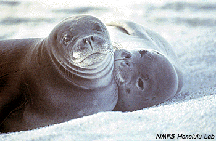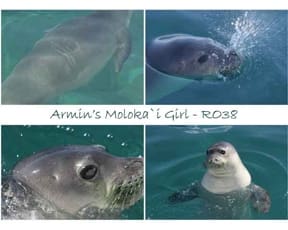Hawaiian Monk Seals
Common name: Hawaiian monk seal
Hawaiian name: ‘ilio-holo-i-ka-ua-ua (dog that runs in the rough sea)
Scientific name: Monachus schauinslandi – from Hugh Hermann Schauinsland, a German scientist who discovered the skull of an animal on Laysan Island in 1899.
- Distribution: Hawaiian Islands
- Size: 400-600 pounds (180-270 kg), 7-8 feet (2.1-2.4 m) long
- Diet: bottom-dwelling and reef fish, eel, octopus, squid and crustaceans
- Average life span: 25-30 years
- Threats: entanglement in marine debris, disturbance by people, aggression by older males, predation by sharks, disease or injury from dogs, and lack of food

Mobbed by a Monk Seal (actually he was quite friendly!) – images by Wild Side
This rare seal is endemic to the Hawaiian Islands, is an important part of Hawaii’s history, and is found nowhere else in the world. Its primary natural habitat lies in the Northwestern Hawaiian Islands, the most remote part of the Hawaiian chain. They are called “monk” seals because they are solitary — like monks — and the soft folds of fur around their necks look similar to the cowls worn by monks.
The Hawaiian monk seal is in crisis: the population is in a decline that has lasted 20 years and only around 1200 monk seals remain. Modeling predicts the species’ population will fall below 1000 animals in the next five years. Like the extinct Caribbean monk seal and the critically endangered Mediterranean monk seal, the Hawaiian monk seal is headed to extinction if urgent action is not taken.
Stretching 7 feet (2.13 meters), the seals are remarkable divers, plunging up to 500 feet (152 meters) to find food and remaining submerged as long as 20 minutes. While they spend most of their time at sea, they come ashore occasionally, notably to give birth. Monk seals don’t react well to human contact — some mothers will abandon their offspring, which helps explain why the survival rate for pups has declined sharply as man has encroached on native habitats.
Occasionally, monk seals are sighted around the major high islands of the Hawaiian chain. Recently, some females have even come ashore to give birth and nurse their pups; these individuals are considered to be “stragglers” from the main population to the northwest.
Hawaiian monk seals naturally spend about a third of their time resting and sleeping on shore. They are not “lazy,” but conserve energy between their hunting and foraging trips. They are known to feed on reef fish, octopus, and lobster, as well as other types of prey.
When they are hunting on the reef, they may stay underwater for more than 15 to 20 minutes, depending on how deep they dive and how active they are underwater. Monk seals have been known to dive to about 1,650 feet (500 m), but most of their diving is probably much shallower.
Large tiger sharks are their main natural predator, and the presence of sharks may be another possible reason for the seals to minimize their time in the water (and maximize their time on the beach).
Monk seals are not social seals and do not form harems or other large groups seen in some seal and sea lion species. Females give birth for the first time at five to nine years of age. Seal pups are usually born in the spring. They nurse for 5 to 6 weeks and can quadruple their birth weight of 35 pounds (16 kg). After weaning, pups live off their fat while they learn to forage for themselves. Some research and recovery projects aim to assure pup and juvenile survival in the wild.
Report monk seal sightings, but don’t approach or disturb them
Learn about monk seals and their need for protected habitat.
Help control marine debris; dispose of rubbish carefully; reduce, reuse, recycle!
Monk seal rules:
Stay 150 feet away from a monk seal, whether in the water or on land.
Keep dogs away from monk seals. They can infect seals with diseases for which they have no immunity.
To report violations or seal injuries, entanglements and sightings, call the National Marine Fisheries Service at 1-888-256-9840.

Color a Monk Seal, National Geographic’s Coloring Book
Hawaiian Monk Seal Activity Booklet, NOAA, Geared for kids with info interesting for adults too
“He appeared suddenly, and paused to look. Our eyes locked. Powerfully built and several times my size, he must have sensed my fear. Or perhaps he heard me bleat through my snorkel. The next instant, the rare Hawaiian monk seal disappeared, back into his underwater cave. I’d just been stared down by one of the rarest marine creatures in the world.”
Wild Side’s wildlife tours focus on education and conservation so that an interactive relationship can be maintained in the best interest of both humans and dolphins. We strive to foster admiration and deep respect for these wonder-full marine mammals.
